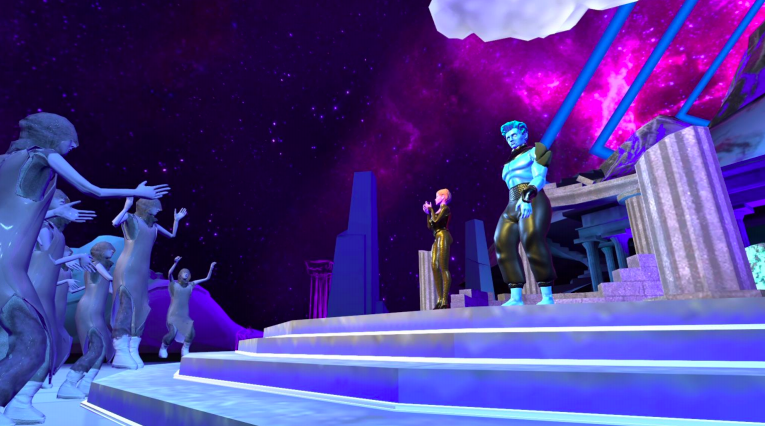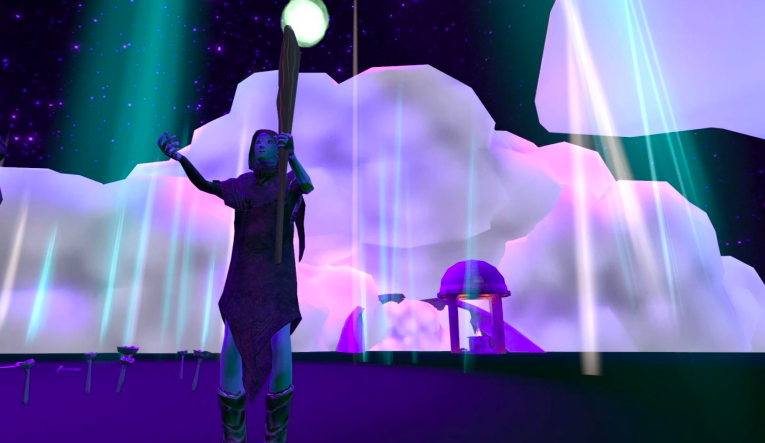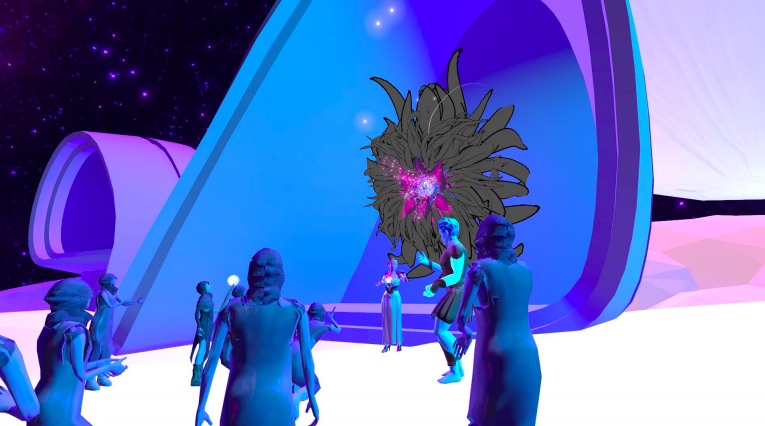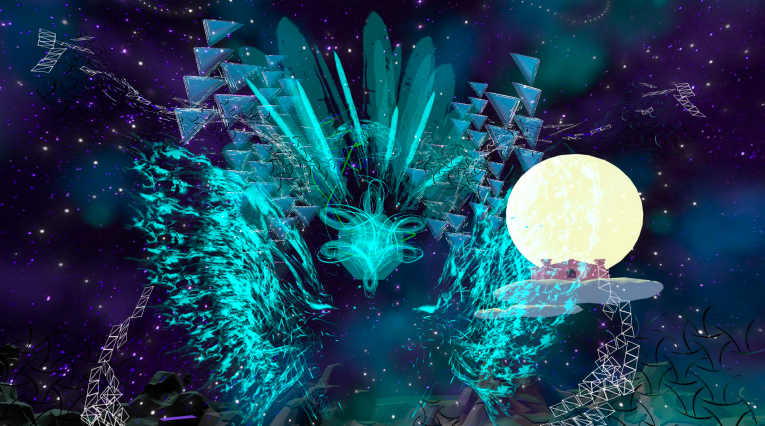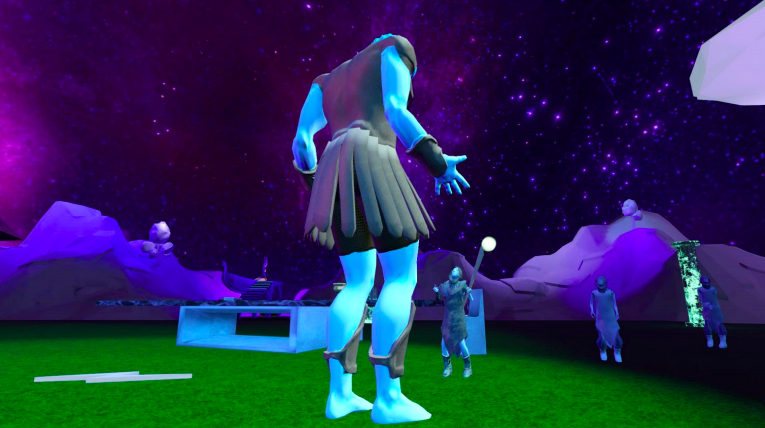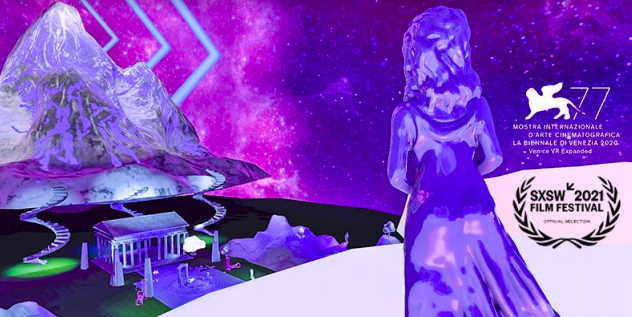Go behind the scenes of this multi-person interactive theater experience powered by VRChat.
Last month the annual South by Southwest Film Festival conducted its first first-ever virtual celebration, allowing festival-goers the chance to experience this years’ incredible projects from the comfort of their homes.
Developed by social XR developer VRrOOm using the popular VR Social platform VRChat, SXSW Online XR did its best to replicate the look and feel of the legendary in-person festivities with virtual renditions of famous Austin venues, including the Cedar Street Courtyard, Contemporary Austin, Empire Control Room & Garage, Mohawk, Paramount Theatre, and Red River Cultural District. Here, attendees could attend virtual screenings, enjoy live musical performances, and experience a generous catalog of interactive mixed-media projects.
This includes Finding Pandora X, a multi-person interactive experience that marries VR technology with live theater to immerse you in a one-of-a-kind theatrical performance. Unlike conventional theater, however, audience members play a role in the story, interacting with the actors and the in-game world to help progress the story.
As members of the Greek Chorus, audience members travel to the world of Mount Olympus to assist the gods—Zeus and Hera—in retrieving hope from Pandora before it’s too late. Along with your fellow companions, you’ll split up and travel to exotic worlds in the hopes of bringing stability to Mount Olympus. Thanks to the branching narrative, each group experiences a different story throughout the experience. At one point during my performance, for example, several members of our group split up to explore an epic city while the rest of us joined Zeus for a few drinks at the base of Mount Olympus. No matter what route you take, however, Finding Pandora X uses the power afforded by VRChat to wow you with impressive visual effects that serve to better enhance the story. Characters grow in size, the in-game world transforms drastically, and the environments are interactive.
At the end of the performance, we joined the cast and crew for several virtual drinks at a heavenly bar located on Mount Olympus; the perfect end to an already intimate experience. In my opinion, this is exactly what makes Finding Pandora X so unique. We’ve seen attempts at live VR theater in the past—such as The Under Presents—but none quite as personal as Finding Pandora X. Whether it be the phenomenal acting or strong emphasis on player interactivity, Double Eye Studio’s unique multi-person experience is the perfect blend of modern technology and classic live theater. Plus you get to keep the custom Greek Chorus avatar for personal use on VRChat, almost like a digital goody-bag.
But what does it take to bring a project as ambitious as this to life? We chatted with some of the cast and crew from Finding Pandora X to learn more about what it’s like to perform in a virtual environment.
As a performer, what—in your opinion—is the biggest difference between performing in VR and the real world?
“In VR you have the difficult task of not only using the acting part of your brain but simultaneously conjuring your inner technician. There is an element of mask work or puppetry where you embody a being who is not you and you try to discover its own truth within yourself,” said Pamela Winslow Kashani aka “Hera.”
“Utilizing the avatars as an authentic extension of yourself. It reminds me a lot of the Ancient kabuki style or Greek theatre which relied heavily on elaborate masks and larger than life physical gestures to communicate effectively. A pose, when well-executed combined with tone of voice can really transcend a moment or a feeling and draw appropriate focus; The same way elegant lighting and staging or cutting to a close up in film would show the audience what’s important to watch,” added Hilary Walker aka “Iris.”
Are there any additional challenges that you wouldn’t normally come across in conventional media, such as film and tv?
“The performers are dealing with all of the challenges that our entire VR industry as well as our tech industry faces daily — instability, growth, unpredictability, latency, bugs….the list goes on. They have to deal with technical hurdles thrown at them quite often, while they are performing live. They could be in the middle of a scene and they get disconnected from the internet, or more. I think this is beyond conventional. However, it also places them at the cutting edge of this field. These actors have become their own technologists,” said Director and Producer Kiira Benzing, adding, “They are living through these moments, making decisions, troubleshooting their own technology while engaging with an audience. I think that overcoming these daily technical challenges prove that these actors are incredibly intelligent, savvy, focused and persistent. I look forward to them leading the way for more actors to embrace this new form of performance in the future.”
“While there are some obvious differences, this experience taught me that there are some things that crossover: You are acting in real-time with your fellow actors even if you are not in the exact same room. You can still feel their energy, but there is not always the same “immediate electricity” that often captivates a space when you’re all sharing a stage in person together. In my opinion, art was never meant to be produced or consumed in a vacuum,” said Walker.
“But Virtual Reality (especially during the pandemic) has become an agile playing field and vehicle for extending shared experiences with a community and providing that human connection we crave in uncharted ways. What does stay the same for me regardless of VR or film/ theatre is my need to find time preshow/ pre-arriving on set to warm up the body: The Voice, my whole instrument and establishing a preshow ritual to help be focused & ready; even more so when you may be more than 3000 miles away from your co-star or distracted by your loud neighbors on the other side of your living room wall who don’t know what magic is taking place one door away.
What is your favorite scene to perform from the show?
“Loved ushering our fearless audience undercover through the tunnels of the underworld while watching Zeus adeptly improvise through the utter chaos as they solve puzzles of Pandora’s plight. One of the highlights for me is improving my “pun game” banter I’ve established every show with my bestie Hermès while onboarding our guests,” said Walker.
“For SXSW we were able to complete a scene that we didn’t have the budget to pull off during our premiere at the Venice FIlm Festival. These scenes involve an animation sequence that I knew would take some time to playtest. Manny Marquez, our Associate Producer and Animation Supervisor worked with us to create these beautiful sequences,” added Benzing. “When we finally got the sequence working our lead actors Jonathan David Martin and Pamela Winslow Kashani were able to play with their relationship physically to those moments. Jonathan’s physical work has always been impressive and I think the work he does at the end of Scene 2 is symbolic of his character’s loss and a really special moment.”
How do you see VR technology playing a role in the future of live performance art?
“There’s a huge possibility here. The technology will need to play catch up to our dreams, but it will become more viable the more people have the hardware and the more the software becomes easier to manipulate,” said Kashani.
“Aside from it being it’s own medium that might allow for nontraditional storylines to be explored in a new way; I think we have the potential to move towards an even more global collaborative space. It would allow artists the means to not only work together at a distance in real time in A way they otherwise might not be able to afford due to budget constraints. It could serve as an additional platform for in person meetings/rehearsals, as well as give artists and designers a chance to walk through design elements or blocking concepts within a live 3-D model without being in the same room,” added Walker.
“I see VR having a major impact on live performance work. I truly believe XR performance and VR Theatre will become its own sub-genre. I find VR a very powerful tool for connection, enabling us to expand to audiences around the globe,” said Benzing.
What skills do you feel are essential for those looking to break into VR acting?
“Experience in lots of spaces and platforms, with strong acting training as a base. Find any opportunity to act in VR, even if you create it yourself,” said Kashani.
“Definitely a sense of curiosity as well as a willingness to fail. Just as with live performances, mishaps happen; people will Miss cues /entrances, you WILL get kicked offline. Confidence and a sense of humor really help; as well as practical Improvisational skills and a willingness to roll with things solo (imperative). Keep training your instrument. Which you should be doing anyway, but I think it’s essential to feel strong in your body and your voice while communicating through avatar,” added Walker.
What do you hope your audience is thinking about after exiting your show?
“I hope they feel exhilarated! The audience goes on some very adventurous quests, and I hope they feel like they have journeyed. We teach them to fly so I hope that they leave with a finally feeling of joy as the leap off the clouds of Mt. Olympus,” said Benzing.
In case you were still wondering if the show is worth the ticket, Finding Pandora X recently took home SXSW’s Audience Award in the Virtual Cinema Spotlight category.
For more information visit here.
Feature Image Credit: Double Eye Studios
The post ‘Finding Pandora X’ Is Live VR Theater At Its Absolute Finest appeared first on VRScout.
